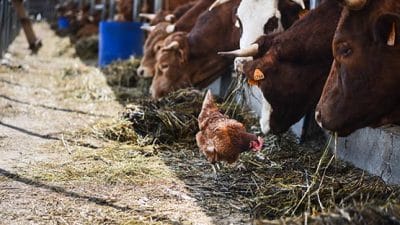
The Virginia Department of Agriculture and Consumer Services (VDACS) announced today the first look at state and national data from the 2012 Ag Census. The preliminary results were provided by the U.S. Department of Agriculture’s National Agricultural Statistics Service (NASS).
“It is terrific to see such a dramatic increase in the value of production coming off of Virginia’s farms in the last 5 years,” said Governor McAuliffe. “Agriculture is Virginia’s largest industry, and it is my administration’s priority to continue that growth through sound policies and aggressive economic development efforts. Increasing farm production puts people back to work in our rural communities and provides the commodities that feed our robust agribusinesses throughout the Commonwealth.”
Virginia also showed a reversal in the loss of farm land in the Commonwealth with a gain of 3%, rising to 8.3 million acres of land held in farms. While farm land has increased, the number of farms has decreased, meaning that farms are growing larger here in Virginia. Farmers in Virginia are also continuing to age, now averaging 59.5 years, up from 58.2 years in 2007, and a full year older than the national average of 58.3 years.
“As Secretary, I am fully committed to helping our farms generate more income through the development of markets both domestically and internationally,” said Secretary of Agriculture and Forestry Todd Haymore. “The increased value of production being sold by Virginia’s farms is an indication that our efforts are making an impact. The ability to generate greater value on the farm enables land to be kept in production rather than being converted to other uses. However, we are not without difficulties here in Virginia. We continue to lose farms at the same time that the average age of our farmers is increasing. My secretariat will continue to focus on these challenges through farm retention programs in our Office of Farmland Preservation such as the Purchase of Development Rights, the Farm Link and Certified Farm Seeker programs.
The preliminary 2012 Census data show the following key trends for Virginia.
- In 2012, the number of farms in Virginia totaled 46,036, down 3 percent (1,347 farms) from 47,383 farms in 2007
- Land in farms, 8.3 million acres, was up 3 percent from 8.1 acres in 2007
- The average size of farm in Virginia was 181 acres, compared to 171 acres in 2007
- Market value of production sold was $3.8 billion, up 29 percent from $2.9 billion in 2007
- The average value of products sold per farm was $81,540 compared to $61,334 in 2007
- The average age of the principal farm operator was 59.5 years, compared to 58.2 years 2007
- There were 38,383 principal male operators and 7,653 principal female operators in 2012, compared to 39,537 male and 7,846 female in 2007
At the national level, the 2012 Census reported little change in land in farms, a more diverse principal operator population and several historic changes in value of sales for U.S. agriculture producers from 2007 to 2012.
Between 2007 and 2012, the amount of land in farms in the United States declined by less than one percent, from 922 million acres to 915 million. While continuing a downward trend, this is the third smallest decline between censuses since 1950 and is within the margin of error.
According to the 2012 Census, principal farm operators are becoming older and more diverse. The average age of a principal farm operator was 58.3 years, up 1.2 years since 2007, and continuing a 30-year trend of steady increase. And, more minority-operated farms were also accounted for in 2012 than in 2007.
The United States had 2.1 million farms, down 4.3 percent in 2012. In terms of farm size by acres, the decline continued a downward trend in mid-sized farms, while the smallest- and largest-size farms held steady.
In 2012, the value of agriculture products sold totaled $394.6 billion, up 33 percent ($97.4 billion) from 2007. For only the second time in Census history, crop sales ($212.4 billion) exceeded livestock sales ($182.2 billion).
“One of the most important takeaways to remember about the Census of Agriculture is that the information is used for decision-making by producers as well as all those who serve farmers, ranchers and rural communities – federal, state and local governments, agribusinesses, trade associations and many others,” said Herman Ellison, State Statistician for usda. “When we look at the data for our state, we can all use it as a snapshot in time to see how Virginia agriculture is changing over time and how it compared to the rest of the country.”
The release of the preliminary 2012 Census of Agriculture results is only a first look at the data and NASS will publish the final report this May. The 2012 Census was not conducted in a typical crop year, and drought had a major impact on U.S. agriculture, affecting crop yields, production and prices. NASS is still reviewing all 2012 Census items to the county level and therefore data is preliminary until published in the final report.
Conducted since 1840, the Census of Agriculture accounts for all U.S. farms and ranches and the people who operate them. When available in May, the final report will provide even more detailed information for Virginia, providing data on all farm operators and data down to the county level. The publication will also provide new insights into the agriculture industry reporting new or expanded data on internet access, regional food systems, biomass production, agro-forestry and equine.
For more information about the Census, including access to the 2012 Census of Agriculture preliminary report and the full report when it is released in May, visit www.agcensus.usda.gov.
According to a 2013 economic impact study conducted by the University of Virginia’s Weldon Cooper Center for Public Service, agriculture and forestry are two of Virginia’s largest industries, with a combined economic impact of $70 billion annually. Agriculture generates more than $52 billion per annum, while forestry induces over $17 billion. The industries also provide more than 400,000 jobs in the Commonwealth.










